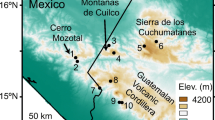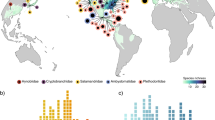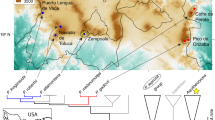Abstract
Bacterial assemblages on the skins of amphibians are known to influence pathogen resistance and other important physiological functions in the host. Host-specific factors and the environment play significant roles in structuring skin assemblages. This study used high-throughput 16S rRNA sequencing and multivariate analyses to examine differences in skin-bacterial assemblages from 246 salamanders belonging to three genera in the lungless family Plethodontidae along multiple spatial gradients. Composition and α- and β-diversity of bacterial assemblages were defined, indicator species were identified for each host group, and the relative influences of host- versus environment-specific ecological factors were evaluated. At the broadest spatial scale, host genus, host species, and sampling site were predictive of skin assemblage structure, but host genus and species were more influential after controlling for the marginal effects of site, as well as nestedness of site. Furthermore, assemblage similarity within each host genus did not change with increasing geographic distance. At the smallest spatial scale, site-specific climate analyses revealed different relationships to climatic variables for each of the three genera, and these relationships were determined by host ecomode. Variation in bacterial assemblages of terrestrial hosts correlated with landscape-level climatic variability, and this pattern decayed with increasing water dependence of the host. Results from this study highlight host-specific considerations for researchers studying wildlife diseases in co-occurring, yet ecologically divergent, species.



Similar content being viewed by others
References
Smith HK, Pasmans F, Dhaenens M, Deforce D, Bonte D, Verheyen K, Lens L, Martel A (2018) Skin mucosome activity as an indicator of Batrachochytrium salamandrivorans susceptibility in salamanders. PLoS One 13(7):e0199295. https://doi.org/10.1371/journal.pone.0199295
Grice EA, Segre JA (2011) The skin microbiome. Nat Rev Microbiol 9(4):244–253. https://doi.org/10.1038/nrmicro2537
Harris RN, Lauer A, Simon MA, Banning JL, Alford RA (2009) Addition of antifungal skin bacteria to salamanders ameliorates the effects of chytridiomycosis. Dis Aquat Organ 83(1):11–16. https://doi.org/10.3354/dao02004
Bletz MC, Loudon AH, Becker MH, Bell SC, Woodhams DC, Minbiole KP, Harris RN (2013) Mitigating amphibian chytridiomycosis with bioaugmentation: characteristics of effective probiotics and strategies for their selection and use. Ecol Lett 16(6):807–820. https://doi.org/10.1111/ele.12099
Loudon AH, Holland JA, Umile TP, Burzynski EA, Minbiole KP, Harris RN (2014) Interactions between amphibians’ symbiotic bacteria cause the production of emergent anti-fungal metabolites. Front Microbiol 5:441. https://doi.org/10.3389/fmicb.2014.00441
Woodhams DC, Brandt H, Baumgartner S, Kielgast J, Küpfer E, Tobler U, Davis LR, Schmidt BR, Bel C, Hodel S, Knight R (2014) Interacting symbionts and immunity in the amphibian skin mucosome predict disease risk and probiotic effectiveness. PLoS One 9(4):e96375. https://doi.org/10.1371/journal.pone.0096375
Flechas SV, Sarmiento C, Cárdenas ME, Medina EM, Restrepo S, Amézquita A (2012) Surviving chytridiomycosis: differential anti-Batrachochytrium dendrobatidis activity in bacterial isolates from three lowland species of Atelopus. PLoS One 7(9):e44832. https://doi.org/10.1371/journal.pone.0044832
McKenzie VJ, Bowers RM, Fierer N, Knight R, Lauber CL (2012) Co-habiting amphibian species harbor unique skin bacterial communities in wild populations. ISME J 6(3):588–596. https://doi.org/10.1038/ismej.2011.129
Kueneman JG, Parfrey LW, Woodhams DC, Archer HM, Knight R, McKenzie VJ (2014) The amphibian skin-associated microbiome across species, space and life history stages. Mol Ecol 23(6):1238–1250. https://doi.org/10.1111/mec.12510
Bataille A, Lee-Cruz L, Tripathi B, Kim H, Waldman B (2016) Microbiome variation across amphibian skin regions: implications for chytridiomycosis mitigation efforts. Microb Ecol 71(1):221–232. https://doi.org/10.1007/s00248-015-0653-0
Muletz-Wolz CR, DiRenzo GV, Yarwood SA, Campbell Grant EH, Fleischer RC, Lips KR (2017) Antifungal bacteria on woodland salamander skin exhibit high taxonomic diversity and geographic variability. Appl Environ Microb 83(9):e00186-e217. https://doi.org/10.1128/AEM.00186-17
Loudon AH, Woodhams DC, Parfrey LW, Archer H, Knight R, McKenzie V, Harris RN (2014) Microbial community dynamics and effect of environmental microbial reservoirs on red-backed salamanders (Plethodon cinereus). ISME J 8(4):830–840. https://doi.org/10.1038/ismej.2013.200
Fitzpatrick BM, Allison AL (2014) Similarity and differentiation between bacteria associated with skin of salamanders (Plethodon jordani) and free-living assemblages. FEMS Microbiol Ecol 88(3):482–494. https://doi.org/10.1111/1574-6941.12314
Rebollar EA, Hughey MC, Medina D, Harris RN, Ibáñez R, Belden LK (2016) Skin bacterial diversity of Panamanian frogs is associated with host susceptibility and presence of Batrachochytrium dendrobatidis. ISME J 10(7):1682–1695. https://doi.org/10.1038/ismej.2015.234
Bird AK, Prado-Irwin SR, Vredenburg VT, Zink AG (2018) Skin microbiomes of California terrestrial salamanders are influenced by habitat more than host phylogeny. Front Microbiol 9:442. https://doi.org/10.3389/fmicb.2018.00442
Walke JB, Becker MH, Loftus SC, House LL, Cormier G, Jensen RV, Belden LK (2014) Amphibian skin may select for rare environmental microbes. ISME J 8(11):2207–2217. https://doi.org/10.1038/ismej.2014.77
Buttimer S, Hernández-Gómez O, Rosenblum EB (2021) Skin bacterial metacommunities of San Francisco Bay Area salamanders are structured by host genus and habitat quality. FEMS Microbiol Ecol 97(12):fiab162. https://doi.org/10.1093/femsec/fiab162
Jiménez RR, Carfagno A, Linhoff L, Gratwicke B, Woodhams DC, Chafran LS, Bletz MC, Bishop B, Muletz-Wolz CR (2022) Inhibitory bacterial diversity and mucosome function differentiate susceptibility of Appalachian salamanders to chytrid fungal infection. Appl Environ Microb 88(8):e01818-e1821. https://doi.org/10.1128/aem.01818-21
Hernández-Gómez O, Kimble SJ, Briggler JT, Williams RN (2017) Characterization of the cutaneous bacterial communities of two giant salamander subspecies. Microb Ecol 73(2):445–454. https://doi.org/10.1007/s00248-016-0859-9
MuletzWolz CR, Yarwood SA, Campbell Grant EH, Fleischer RC, Lips KR (2017) Effects of host species and environment on the skin microbiome of Plethodontid salamanders. J Anim Ecol 87(2):341–353. https://doi.org/10.1111/1365-2656.12726
Bletz MC, Archer H, Harris RN, McKenzie VJ, Rabemananjara FC, Rakotoarison A, Vences M (2017) Host ecology rather than host phylogeny drives amphibian skin microbial community structure in the biodiversity hotspot of Madagascar. Front Microbiol 8:1530. https://doi.org/10.1038/ismej.2017.41
Nekola JC, White PS (1999) The distance decay of similarity in biogeography and ecology. J Biogeog 26(4):867–878. https://doi.org/10.1046/j.1365-2699.1999.00305.x
Tornero I, Boix D, Bagella S, Pinto-Cruz C, Caria MC, Belo A, Lumbreras A, Sala J, Compte J, Gascón S (2018) Dispersal mode and spatial extent influence distance-decay patterns in pond metacommunities. PLoS One 13(8):e0203119. https://doi.org/10.1371/journal.pone.0203119
Feng M, Tripathi BM, Shi Y, Adams JM, Zhu YG (2019) Chu H (2019) Interpreting distance-decay pattern of soil bacteria via quantifying the assembly processes at multiple spatial scales. MicrobiologyOpen 8(9):e00851. https://doi.org/10.1002/mbo3.851
Hairston NG (1949) The local distribution and ecology of the plethodontid salamanders of the southern Appalachians. Ecol Monogr 19(1):47–73
Duellman WE, Sweet SS (1999) Distribution patterns of amphibians in the Nearctic region of North America. Patterns of Distribution of Amphibians. Johns Hopkins Univ. Press, Baltimore, Maryland, pp 31–109
Niemiller ML, Reynolds RG (eds.) (2011) The Amphibians of Tennessee. University of Tennessee Press.
Omernik JM (1987) Ecoregions of the conterminous United States. Map (scale 1:7,500,000). Ann Assoc Am Geogr 77:118–125
Griffith GE, Omernik JM, Azevedo SH (1998) Ecoregions of Tennessee (Map poster). US Geological Survey, Reston, VA.
Krzysik AJ (1979) Resource allocation, coexistence, and the niche structure of a streambank salamander community. Ecol Monogr 49(2):173–194. https://doi.org/10.2307/1942512
Niemiller ML, Miller BT (2007) Subterranean reproduction of the southern two-lined salamander (Eurycea cirrigera) from Short Mountain. Tennessee Herpetol Conserv Biol 2(2):106–112
Conant R, Collins JT (1998) A field guide to reptiles and amphibians: eastern and central North America. Houghton Mifflin Harcourt.
Schloss PD, Westcott SL, Ryabin T, Hall JR, Hartmann M, Hollister EB, Lesniewski RA, Oakley BB, Parks DH, Robinson CJ, Sahl JW (2009) Introducing mothur: open-source, platform-independent, community-supported software for describing and comparing microbial communities. Appl Environ Microb 75(23):7537–7541. https://doi.org/10.1128/AEM.01541-09
Glassman SA, Martiny JB (2018) Broadscale ecological patterns are robust to use of exact sequence variants versus operational taxonomic units. MSphere 3(4):e00148-e218. https://doi.org/10.1128/mSphere.00148-18
Schloss PD (2021) Amplicon sequence variants artificially split bacterial genomes into separate clusters. Msphere 6(4):e00191-e221. https://doi.org/10.1128/mSphere.00191-21
Quast C, Pruesse E, Yilmaz P, Gerken J, Schweer T, Yarza P, Peplies J, Glöckner FO (2012) The SILVA ribosomal RNA gene database project: improved data processing and web-based tools. Nucleic Acids Res 41(D1):D590–D596. https://doi.org/10.1093/nar/gks1219
Weiss S, Xu ZZ, Peddada S, Amir A, Bittinger K, Gonzalez A, Lozupone C, Zaneveld JR, Vázquez-Baeza Y, Birmingham A, Hyde ER (2017) Normalization and microbial differential abundance strategies depend upon data characteristics. Microbiome 5(1):1–8. https://doi.org/10.1186/s40168-017-0237-y
Anderson MJ, Crist TO, Chase JM, Vellend M, Inouye BD, Freestone AL, Sanders NJ, Cornell HV, Comita LS, Davies KF, Harrison SP (2011) Navigating the multiple meanings of β diversity: a roadmap for the practicing ecologist. Ecol Lett 14(1):19–28. https://doi.org/10.1111/j.1461-0248.2010.01552.x
R Core Team (2019) R: A language and environment for statistical computing. R Foundation for Statistical Computing, Vienna, Austria. ISBN 3–900051–07–0. http://www.R-project.org/
Anderson MJ, Ellingsen KE, McArdle BH (2006) Multivariate dispersion as a measure of beta diversity. Ecol Lett 9(6):683–693. https://doi.org/10.1111/j.1461-0248.2006.00926.x
Dufrêne M, Legendre P (1997) Species assemblages and indicator species: the need for a flexible asymmetrical approach. Ecol Monogr 67(3):345–366. https://doi.org/10.1890/0012-9615(1997)067[0345:SAAIST]2.0.CO;2
De Cáceres MD, Legendre P (2009) Associations between species and groups of sites: indices and statistical inference. Ecology 90(12):3566–3574. https://doi.org/10.1890/08-1823.1
Grisnik M, Grinath JB, Walker DM (2021) The presence of Pseudogymnoascus destructans, a fungal pathogen of bats, correlates with changes in microbial metacommunity structure. Sci Rep-UK 11(1):1–4. https://doi.org/10.1038/s41598-021-91118-1
Hijmans RJ, Cameron SE, Parra JL, Jones PG, Jarvis A (2005) Very high resolution interpolated climate surfaces for global land areas. Int J Climatol 25(15):1965–1978. https://doi.org/10.1002/joc.1276
Rissler LJ, Apodaca JJ (2007) Adding more ecology into species delimitation: ecological niche models and phylogeography help define cryptic species in the black salamander (Aneides flavipunctatus). Systematic Biol 56(6):924–942. https://doi.org/10.1080/10635150701703063
Hijmans RJ, Elith J (2013) Species distribution modeling with R. R CRAN Project.
Legendre P, Anderson MJ (1999) Distance-based redundancy analysis: testing multispecies responses in multifactorial ecological experiments. Ecol Monogr 69(1):1–24
Yap TA, Nguyen NT, Serr M, Shepack A, Vredenburg VT (2017) Batrachochytrium salamandrivorans and the risk of a second amphibian pandemic. EcoHealth 14(4):851–864. https://doi.org/10.1007/s10393-017-1278-1
Woodhams DC, Alford RA, Antwis RE, Archer H, Becker MH, Belden LK, Bell SC, Bletz M, Daskin JH, Davis LR, Flechas SV (2015) Antifungal isolates database of amphibian skin-associated bacteria and function against emerging fungal pathogens: Ecological Archives E096–059. Ecology 96(2):595. https://doi.org/10.1890/14-1837.1
Carrión VJ, Perez-Jaramillo J, Cordovez V, Tracanna V, De Hollander M, Ruiz-Buck D, Mendes LW, van Ijcken WF, Gomez-Exposito R, Elsayed SS, Mohanraju P (2019) Pathogen-induced activation of disease-suppressive functions in the endophytic root microbiome. Science 366(6465):606–612. https://doi.org/10.1126/science.aaw9285
Sangwan P, Chen X, Hugenholtz P, Janssen PH (2004) Chthoniobacter flavus gen. nov., sp. nov., the first pure-culture representative of subdivision two, Spartobacteria classis nov., of the phylum Verrucomicrobia. Appl Environ Microb 70(10):5875–5881. https://doi.org/10.1128/AEM.70.10.5875-5881.2004
Bates KA, Shelton JM, Mercier VL, Hopkins KP, Harrison XA, Petrovan SO, Fisher MC (2019) Captivity and infection by the fungal pathogen Batrachochytrium salamandrivorans perturb the amphibian skin microbiome. Front Microbiol 2019:1834. https://doi.org/10.3389/fmicb.2019.01834
Garcia R, Müller R (2014) The family Polyangiaceae. In: Rosenberg E, DeLong EF, Lory S, Stackebrandt E, & Thompson F, eds. The Prokaryotes: Deltaproteobacteria and Epsilonproteobacteria (4th ed., pp. 247–279). Springer, Berlin, Heidelberg. https://doi.org/10.1007/978-3-642-39044-9_308
Trujillo ME, Hong K, Genilloud O (2014) The family Micromonosporaceae. In: Rosenberg E, DeLong EF, Lory S, Stackebrandt E, Thompson F, eds. The Prokaryotes: Actinobacteria (4th ed., pp. 499–569). Springer, Berlin, Heidelberg. https://doi.org/10.1007/978-3-642-30138-4_196
Sheremet A, Jones GM, Jarett J, Bowers RM, Bedard I, Culham C, Eloe-Fadrosh EA, Ivanova N, Malmstrom RR, Grasby SE, Woyke T (2020) Ecological and genomic analyses of candidate phylum WPS-2 bacteria in an unvegetated soil. Environ Microbiol 22(8):3143–3157. https://doi.org/10.1111/1462-2920.15054
DiRenzo GV, Longo AV, Muletz-Wolz CR, Pessier AP, Goodheart JA, Lips KR (2021) Plethodontid salamanders show variable disease dynamics in response to Batrachochytrium salamandrivorans chytridiomycosis. Biol Invasions 23:2797–2815. https://doi.org/10.1007/s10530-021-02536-1
Carter ED, Miller DL, Peterson AC, Sutton WB, Cusaac JP, Spatz JA, Rollins-Smith L, Reinert L, Bohanon M, Williams LA, Upchurch A (2020) Conservation risk of Batrachochytrium salamandrivorans to endemic lungless salamanders. Conserv Letter 13(1):e12675. https://doi.org/10.1111/conl.12675
Vazquez VM, Rothermel BB, Pessier AP (2009) Experimental infection of North American plethodontid salamanders with the fungus Batrachochytrium dendrobatidis. Dis Aquat Organ 84(1):1–7. https://doi.org/10.3354/dao02026
Acknowledgements
The authors would like to thank B. Edelbrock, G. Russell, F. Erdman, R. Buck, C. Hall, J. Leys, M. Leys, I. Papraniku, S. Nolte, A. Moore, and D. Wilson for assistance in the field.
Funding
This research was funded by the Great Smoky Mountains Conservation Association Campbell Fellowship, The Herpetologists’ League E.E. Williams Research Grant, and The Tennessee Herpetological Society Chadwick Lewis Memorial Grant.
Author information
Authors and Affiliations
Contributions
The three authors contributed to all aspects of conceptualization, methodology, formal analysis, investigation, and data curation. AJH wrote the manuscript and all authors contributed to revisions. All authors have agreed to the published version of the manuscript.
Corresponding author
Ethics declarations
Ethics Approval
All procedures involving animals were approved by the appropriate government agencies, including the United States Department of the Interior National Park Service (permit no. GRSM-2017-SCI-1263), the Tennessee Wildlife Resources Agency (permit no. 3886), the State of Tennessee Department of Environment and Conservation, Division of Natural Areas (permit no. 2016–026), and by the Tennessee Technological University Institutional Animal Care and Use Committee (permit no. 15–16-001).
Competing Interests
The authors declare no competing interests.
Supplementary Information
Below are links to electronic supplementary materials.
Rights and permissions
Springer Nature or its licensor (e.g. a society or other partner) holds exclusive rights to this article under a publishing agreement with the author(s) or other rightsholder(s); author self-archiving of the accepted manuscript version of this article is solely governed by the terms of such publishing agreement and applicable law.
About this article
Cite this article
Hill, A.J., Grisnik, M. & Walker, D.M. Bacterial Skin Assemblages of Sympatric Salamanders Are Primarily Shaped by Host Genus. Microb Ecol 86, 1364–1373 (2023). https://doi.org/10.1007/s00248-022-02127-0
Received:
Accepted:
Published:
Issue Date:
DOI: https://doi.org/10.1007/s00248-022-02127-0




